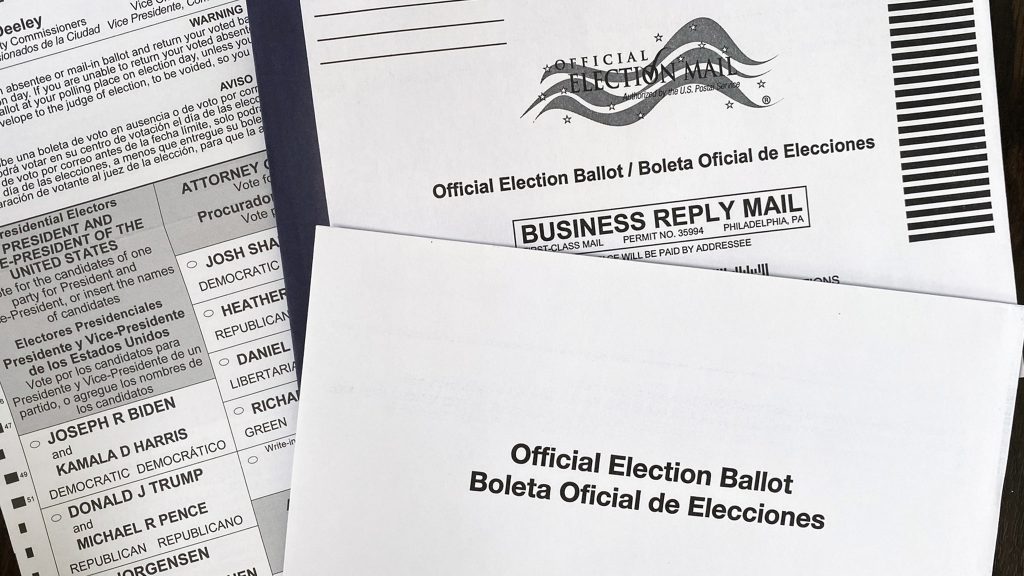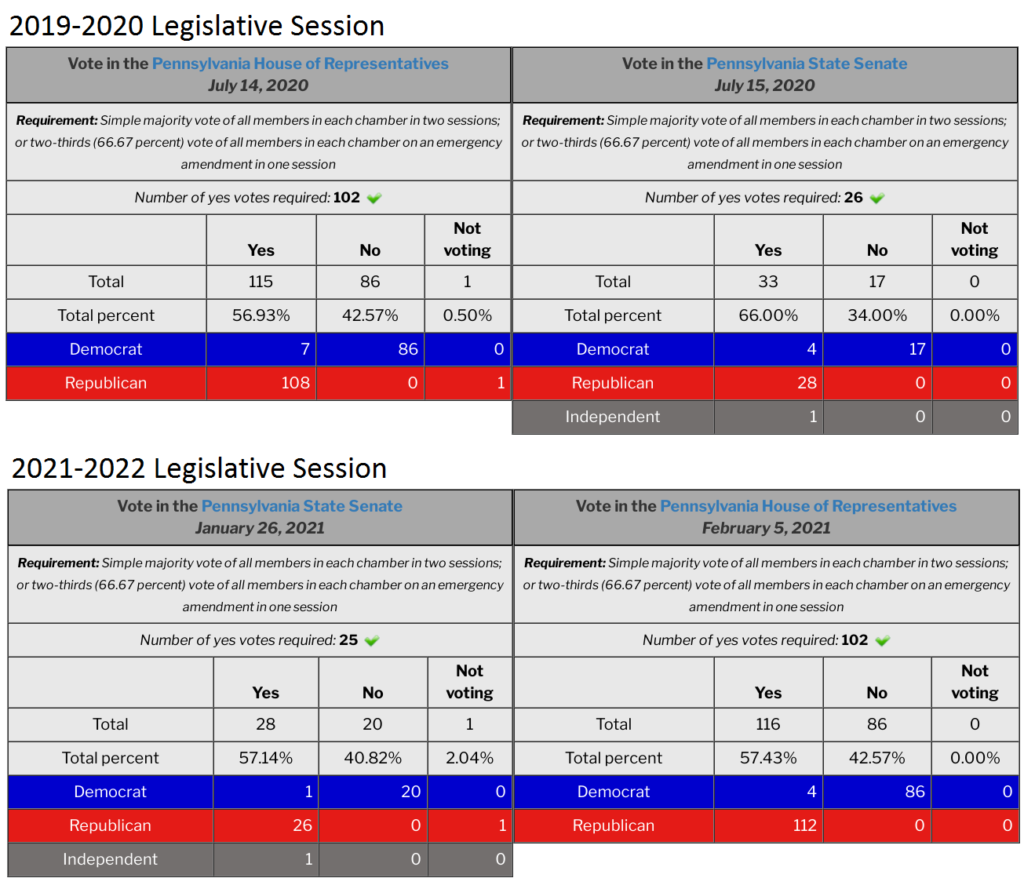In last week’s post, we looked at the first two of four ballot measures that will be open to all Pennsylvania voters in this May’s primary election. I was thrilled to learn that my friends and family who are registered as independents or third-party voters would be able to voice their opinions on these important issues. I was also frustrated (but not surprised) to see that the wording on some of these ballot questions is clear as mud, if not misleading.
In Pennsylvania, the state legislature can propose amendments to the state constitution, which are then ratified by the voters. In order for an amendment to make it onto a ballot, the same language must be passed by both branches of the state legislature in two consecutive sessions. At that point, it is then added to the ballot to be accepted or rejected by the general electorate.
Just Say… Yes?
Based on a few examples of biased language in last week’s post, it is clear that the way a question is worded can impact how people vote. According to Ballotpedia, “between 1995 and 2020, the state legislature referred 10 constitutional amendments to the ballot. All 10 of the constitutional amendments were approved. As of 2020, voters last rejected a constitutional amendment in 1981.”[1]
Given this statistic, is the legislature just that good and that tuned into the needs of their constituents, or do we the voters just tend to vote “yes” without fully understanding the issue as long as the language sounds good? Of course, I couldn’t find a definitive answer to that question, but it was interesting to learn that “every state but Delaware requires voters to ratify proposed state constitutional amendments,” and that “from 2006 through 2020, a total of 1,016 constitutional amendments were proposed and put before voters. Of this total, voters approved 733 proposed changes to state constitutions.”[2]

Researchers have looked at our emotional responses to the wording on ballot measures, and there is (unsurprisingly) a trend in responses based on how the issue is framed. Framing language that focuses on a negative, or eliminating something bad, can result in lower approval ratings or fewer “yes” votes. However, framing language that focuses on supporting something that sounds positive, or protecting something good, can result in higher numbers of “yes” votes. The example used in one study was related to ballot language about same-sex marriage, in which voters were asked to “eliminate protections” for same-sex couples vs. “protect marriage” for male-female couples. The latter option saw higher approval ratings even though both questions effectively said the same thing. It also appears that framing language determines not only how some people vote, but if they vote.[3]
Whenever I am doing election research and sharing information on this blog, I try to leave my own opinion out of it and focus on the issues as much as possible. I think political parties in general, but our two major parties in particular, have done our country an extreme disservice in distorting and flattening complex issues into stark “us vs. them” decisions. I’ve seen endless examples of double standards, in which a friend or family member will agree with a member of their own party saying something, but vehemently disagree with a member of the opposite party saying the same thing.
Since there is so much partisan media in our newsfeeds, with pundits telling us what to think, not how to examine the issues, I was hesitant to include any information about the partisan history of these ballot questions in this blog post. It is not my goal to tell people how to vote, and I don’t even want to influence someone to cast a vote in a certain way by sharing which parties voted for/against these amendments. With that said, as I dove into the details, I did find it to be a fascinating study of the process. So here it goes…
Constitutional Amendments in Pennsylvania
Approval of an emergency constitutional amendment in Pennsylvania requires simple majority (51%) approval in both chambers during two consecutive legislative sessions or super majority (66.67%) approval in both chambers during one legislative session.

Image credit: [4]
The first votes on this package of three amendments took place during the 2019-2020 session of the state legislature. It first went to the Pennsylvania House of Representatives on July 14, 2020 and needed at least 102 votes to reach simple majority. It received 115, or 57% of the votes. All 108 Republicans who voted (one wasn’t there) voted yes, along with seven Democrats. Eighty-six Democrats voted no. The package then went to the State Senate on July 15, where it also needed at least a simple majority to pass: 26 votes. All 28 Republicans, along with four Democrats and one Independent, voted yes, giving it a total of 33 yes votes, or 66%
After that, we had an election. Almost all of our attention was turned toward presidential race, but we elected a new set of state senators and representatives as well, and those officials held a second vote on the constitutional amendment package at the beginning of the 2021-2022 legislative session. The State Senate got right to business and voted on January 26, 2021: all 26 Republicans who voted (one wasn’t there) voted yes, along with one Democrat and one Independent, giving a 57% majority approval. It then went to the House of Representatives, where all 112 Republicans and four Democrats voted yes, also giving it a 57% majority.
As I mentioned last week, the first two proposed amendments are a direct result from outrage over Governor Wolf’s decisions during the COVID-19 pandemic to declare a state of emergency and close businesses and schools to prevent further spread of the virus. The state legislature passed a resolution last summer to end his emergency declaration, which he vetoed, and they were unable to get the two-thirds majority necessary to override his veto. The first two amendments would circumvent the requirement for a two-thirds majority, allowing the state legislature to overturn emergency declarations with a simple majority.
While this constitutional amendment was in the works in 2020, State Senator Vincent Hughes “proposed that the bill also include a constitutional amendment addressing equality of rights. The Pennsylvania State Senate added Sen. Hughes’ proposal to the bill through a unanimous vote.”[5] And that brings us to the third question on Pennsylvanians’ ballot this May.

Image credits: [6]
Ballot Question 3: Proposed Constitutional Amendment – Article I
This question deals with equality of rights based on race and ethnicity, and it was introduced in the wake of the instances of police brutality and resulting protests in 2020. The Pennsylvania constitution and federal laws currently provide broad protections against discrimination “against any person in exercise of any civil right.” This proposed amendment specifically focuses on protecting individuals from racial and ethnic discrimination by Pennsylvania governmental entities and solely on the basis of race and ethnicity.
Passing the amendment would enshrine protections against discrimination in the Pennsylvania constitution, independent of the U.S. Constitution and federal laws. However, there are concerns about how the language may be interpreted in the court system. There is a possibility that this amendment could open the door for “reverse discrimination” cases and for broad removal of race and ethnicity questions in hiring, admissions, contracting, and other opportunities to support diversity.
- Voting YES means that you agree that all levels of Pennsylvania government, entities, and institutions be prohibited from discriminating against individuals because of their race or ethnicity.
- Voting NO means that you disagree with changing Pennsylvania law since current state and federal laws already provide protections against discrimination by all levels of Pennsylvania government, entities, and institutions.
Ballot Question 4: Statewide Referendum – Act 2020-91
This question is not a constitutional amendment, but a statewide referendum, and it deals with making municipal fire and emergency medical services companies eligible for loans. It was introduced because the General Assembly determined there was a need for these emergency responder companies to update their facilities and equipment. At the moment, only volunteer fire and EMS companies are authorized to apply for loans from this program.
Passing the amendment would not increase the pool of loan money available; it would only increase the number of applicants eligible to apply for the loans. If passed, paid fire and EMS companies would be able to improve their equipment and facilities, but as the applicant pool increases, the acceptance rate for loan applications will decrease, limiting funding to volunteer companies.
- Voting YES means that you support expanding PA’s loan program to include paid municipal fire and emergency medical services, as well as volunteer companies.
- Voting NO means that you support keeping PA’s loan program available to volunteer fire and emergency medical service companies, and not to paid companies.
~
Understanding the language and implications of ballot measures is a critical step in the voting process. I’ve made uninformed, knee-jerk decisions in the voting booth before, and based on how some questions have been written over the years, it’s clear that legislators often count on voters being uninformed.
Speaking of uninformed, next week I will do what I can to illuminate myself on the ballot’s judicial races. Until then, here is a link to my election spreadsheet:
Thanks for reading!
[1] https://ballotpedia.org/Pennsylvania_Question_3,_Equal_Rights_Regardless_of_Race_or_Ethnicity_Amendment_(May_2021)
[2] https://ballotpedia.org/Amending_state_constitutions
[3] https://journalistsresource.org/politics-and-government/state-ballot-questions-power-wording-experiment-framing-issues/
[4] https://billypenn.com/2020/10/04/pennsylvania-naked-ballot-mail-voting-guide-secrecy-envelope-deadline-signature-philadelphia/
[5] https://ballotpedia.org/Pennsylvania_Question_3,_Equal_Rights_Regardless_of_Race_or_Ethnicity_Amendment_(May_2021)
[6] https://ballotpedia.org/Pennsylvania_Question_3,Equal_Rights_Regardless_of_Race_or_Ethnicity_Amendment(May_2021)
1 Comment
Voting: the ballot questions – The Bethlehem Gadfly · April 28, 2021 at 2:02 pm
[…] May 2021 Election Guide — PA Primaries, Part 2 […]